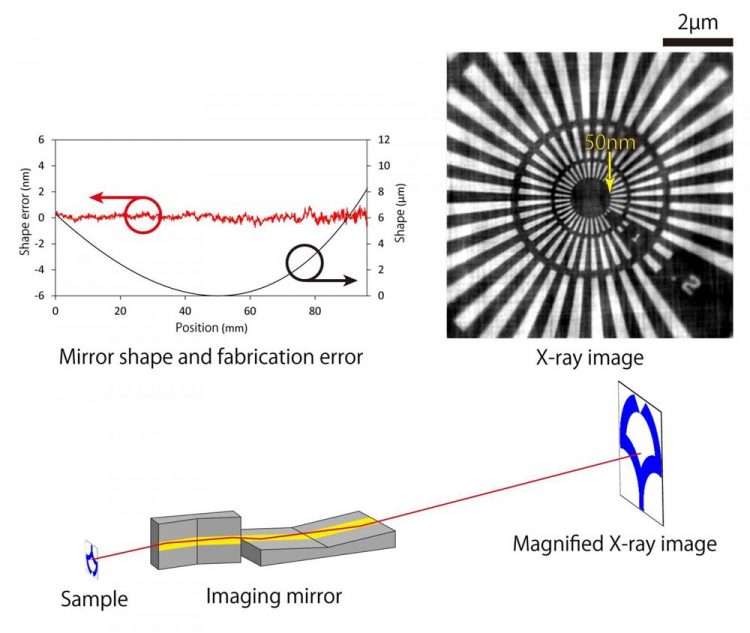X-ray microscope optics resolve 50-nm features while eliminating chromatic aberrations

This is a schematic of an achromatic X-ray microscope based on total-reflection mirrors. Credit: Osaka University
X-ray microscopes are commonly used in combination with full-field imaging techniques in spectromicroscopy applications, where they allow the chemical structures of materials to be analyzed and visualized simultaneously.
However, the performance of these microscopes is often affected by problems with chromatic aberrations– optical effects that limit the resolution or degree of fineness to which images of the material structures can be acquired–and previous solutions to the problem have often proved difficult to manufacture and implement.
A collaborative team led by researchers from Osaka University has therefore developed an optical system for use in full-field X-ray microscopes that offers a more practical way to overcome the chromatic aberration problem.
“We developed an imaging optical system based on use of two monolithic imaging mirrors,” says Assistant Professor Satoshi Matsuyama from Osaka University's Graduate School of Engineering. “These mirrors have elliptical and hyperbolic shapes on a single substrate, and fixing of the relative positioning between the ellipse and the hyperbola can provide high image quality with lasting stability.”
Fabrication of this complex mirror system meant that existing manufacturing processes had to be modified, but the proposed mirror structures were produced with the required shapes to an accuracy of approximately 1 nm.
After the mirror structure was assembled using a specially developed alignment system, it was implemented in a full-field X-ray microscope system for performance testing at the SPring-8 synchrotron radiation facility.
“The microscope was tested for its spatial resolution, the presence of chromatic aberrations, and long-term stability using a fine test pattern called a Siemens star and a photon energy of approximately 10 keV,” explains Professor Kazuto Yamauchi of Osaka University's Center for Ultra-Precision Science and Technology. “We were able to clearly resolve 50-nm-sized features with high stability over a period of 20 hours without any chromatic aberrations.”
The developed system was then applied in X-ray absorption fine structure spectromicroscopy experiments, and successfully identified both elements and chemical states in micron-sized specimens of zinc and tungsten.
While the system will be subjected to further research to improve its performance towards the theoretical limit, it already shows considerable promise for use in a wide range of applications, including ultra-fast imaging with high-intensity X-rays and high-resolution full-field X-ray fluorescence imaging.
This mirror structure may also find use in other systems, with potential applications that include focusing and imaging optics for synchrotron radiation X-rays and X-ray-free electron lasers.
Media Contact
All latest news from the category: Physics and Astronomy
This area deals with the fundamental laws and building blocks of nature and how they interact, the properties and the behavior of matter, and research into space and time and their structures.
innovations-report provides in-depth reports and articles on subjects such as astrophysics, laser technologies, nuclear, quantum, particle and solid-state physics, nanotechnologies, planetary research and findings (Mars, Venus) and developments related to the Hubble Telescope.
Newest articles

Silicon Carbide Innovation Alliance to drive industrial-scale semiconductor work
Known for its ability to withstand extreme environments and high voltages, silicon carbide (SiC) is a semiconducting material made up of silicon and carbon atoms arranged into crystals that is…

New SPECT/CT technique shows impressive biomarker identification
…offers increased access for prostate cancer patients. A novel SPECT/CT acquisition method can accurately detect radiopharmaceutical biodistribution in a convenient manner for prostate cancer patients, opening the door for more…

How 3D printers can give robots a soft touch
Soft skin coverings and touch sensors have emerged as a promising feature for robots that are both safer and more intuitive for human interaction, but they are expensive and difficult…





















